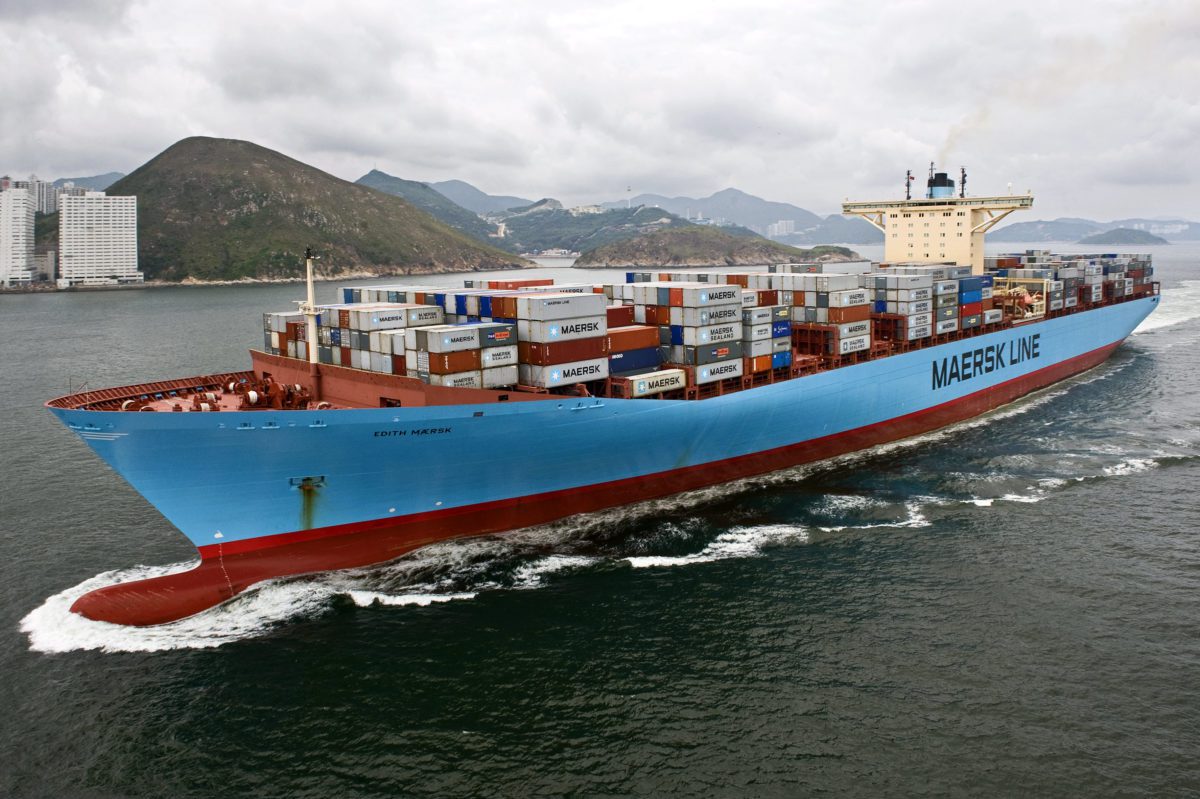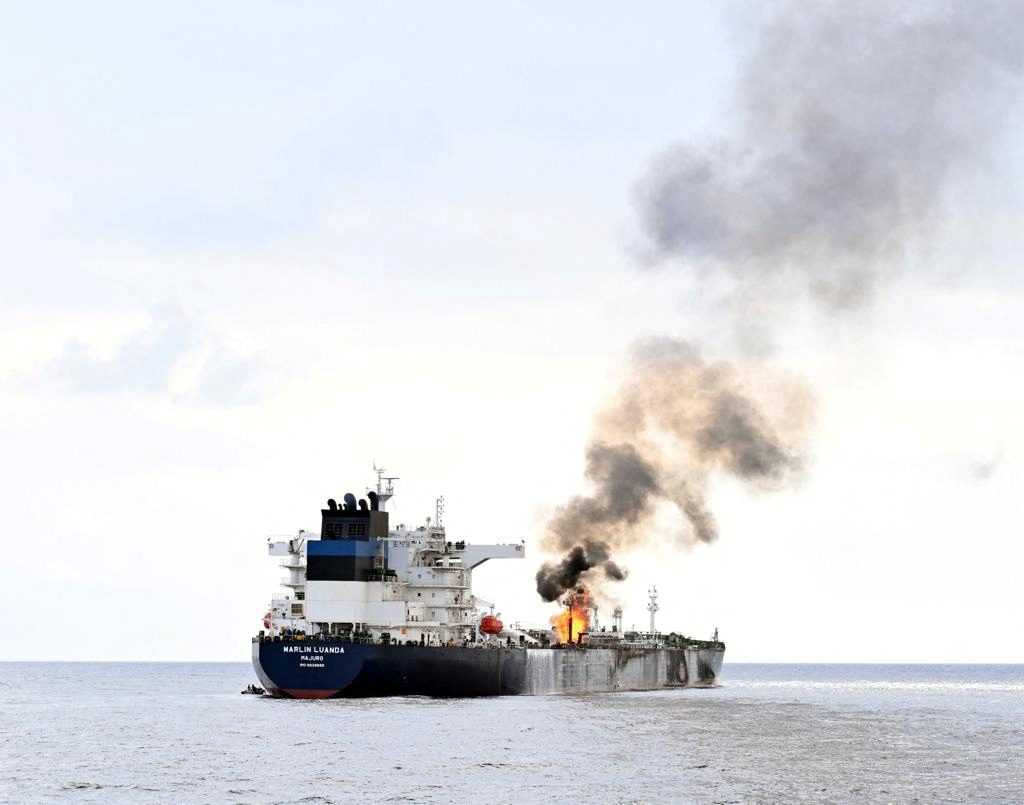Maersk post-panamax container ship heads for the berth at Pier 400 Los Angeles. Image (c) APM Terminals
(Bloomberg) — A.P. Moeller-Maersk A/S Chief Executive Officer Nils Smedegaard Andersen said he’ll be forced to prolong cost cuts at the world’s biggest container line as a policy of capacity restraint fails to lift shipping rates.
The company’s Maersk Line unit is seeking new ways to slim expenses even after a 7.1 percent reduction in the first quarter put the Copenhagen-based company on a more competitive footing than most of its rivals, Andersen said in an interview.
While resurgent U.S. demand should buoy volumes on North Pacific sailings, Andersen said there’s little sign of a revival on key routes transporting Asian-made consumer goods to markets in Europe. That makes cost cuts vital if Maersk is to deliver on its target of boosting net income this year even after last week halving its estimate for global container-volume growth.
“We will have to accept that for as long as there’s overcapacity, there will be price wars,” Andersen said in an interview in Copenhagen. “All we can do is shrug our shoulders and focus on making Maersk Line as competitive as possible, on cutting costs and on nurturing customer relations.”
The Shanghai Containerized Freight Index, which measures the cost of shipping boxes from China, the No. 1 export nation, has fallen for nine consecutive weeks as companies cut rates.
Trading Lower
Shares of A.P. Moeller-Maersk, which controls 15 percent of the container-market by capacity via Maersk Line, fell as much as 3.4 percent today, the most since April 12, and were trading 2.9 percent lower at 41,240 kroner as of 10:01 a.m. local time.
The stock has lost 24 percent since the end of 2007, valuing the company at 177 billion kroner ($31 billion), during which time the Stoxx Europe 600 Index has declined 16 percent.
Industry No. 2 Mediterranean Shipping Co. of Geneva, with a 13.5 percent market share, and No. 3 Marseille-based CMA CGM SA, with 8.5 percent, based on Alphaliner data, are closely held.
Maersk Line’s parent was yesterday downgraded to hold from buy by analyst Robin Byde at Cantor Fitzgerald in London. Byde said that as rates fall the shipping unit’s cost advantage won’t be enough to sustain gains that saw it post first-quarter net income of $204 million even as most peers lost money.
Drewry Maritime Equity Research said last week that rate volatility “will be a defining feature of the decade.”
Supply is exceeding demand for a fifth straight year, and the consultant forecasts the global container fleet will expand a further 7.5 percent in 2013, far exceeding demand growth of 4.5 percent and putting renewed downward pressure on prices.
Declining Workforce
Maersk’s view is even bleaker, with the company forecasting growth as low as 2 percent for the year in its latest results presentation on May 17, down from 4 percent previously.
While Andersen cites Europe as “dragging down the global economy,” he said the widening gulf between supply and demand reflects a failure to curb capacity that will prompt a further fall in container rates that are already below break-even for the industry as a whole.
“Cost improvements will compensate for the setback everyone will suffer during a price war,” Andersen added, declining to say whether Maersk will fire workers. “Cutting costs and making costs stay low is an ongoing exercise that isn’t stopping.”
Maersk Line scrapped about 3,000 jobs under the Streamline restructuring plan introduced in 2008 after the credit crunch and global recession sent demand tumbling. More posts have gone since, including 400 last year, 250 of them in Copenhagen, and it now employs about 25,000 people, 7,000 of them seafarers.
Triple-E
Maersk has also pared expenses by operating ships at lower, more fuel-efficient speeds, known as slow-steaming. Its vessels typically sail at 16-18 knots, compared with 20 knots in 2008, and the practice has become standard across the industry.
Parent A.P. Moeller-Maersk, which also owns an oil exploration unit and a drilling division, has additionally used its financial strength to invest in more cost-efficient ships.
The 20 Triple-E vessels, the first of which will be handed over next month, will be the biggest afloat and carry 18,000 containers while consuming about 35 percent less fuel per box than the 13,100-capacity ships operated by rivals, Maersk says.
The 400-meter (1,312-foot) craft able to carry 18 million flat-screen televisions were ordered at a cost of $3.8 billion in 2011, marking Maersk’s first ship purchase since 2008, as double-digit growth in container volumes the previous year seemed to indicate the end of the cargo slump.
Replacement Plan
Maersk says it’s happy to be taking the ships from South Korea’s Daewoo Shipbuilding & Marine Engineering Co., but has abandoned plans to establish two fleets of 10 Triple-Es to lift capacity and will instead use the first 12 to replace older vessels on an existing service linking Shanghai and Rotterdam.
While Andersen said that the U.S. economy is “moving in the right direction,” the Triple-E is too large to navigate the Panama Canal and therefore ill-suited to trans-Pacific use, and the last eight are also likely to displace older craft in the absence of a strong rebound in Asia-Europe traffic.
Andersen said cost cuts can only take companies so far, and that Maersk itself won’t be able sustain the pace of its first- quarter reduction, meaning capacity discipline remains the only step able to delivery enduring stability in the current climate.
“In the past, price wars only reduced profits,” he said. “Now they are causing losses. There has to be a strong push from the industry to restore rates.”
– Christian Wienberg, Copyright 2013 Bloomberg.
Unlock Exclusive Insights Today!
Join the gCaptain Club for curated content, insider opinions, and vibrant community discussions.

 Join The Club
Join The Club













